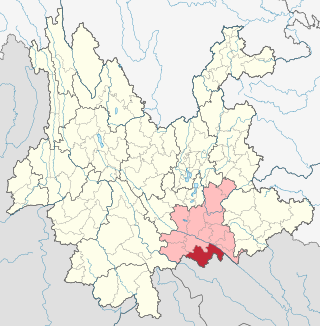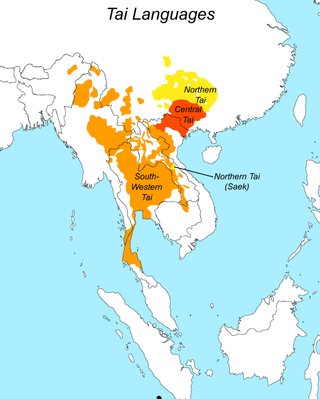
The Bulang people are an ethnic group. They form one of the 56 ethnic groups officially recognized by the People's Republic of China.

Tai Lue or Xishuangbanna Dai is a Tai language of the Lu people, spoken by about 700,000 people in Southeast Asia. This includes 280,000 people in China (Yunnan), 200,000 in Burma, 134,000 in Laos, 83,000 in Thailand and 4,960 in Vietnam. The language is similar to other Tai languages and is closely related to Kham Mueang or Tai Yuan, which is also known as Northern Thai language. In Yunnan, it is spoken in all of Xishuangbanna Dai Autonomous Prefecture, as well as Jiangcheng Hani and Yi Autonomous County in Pu'er City.

Mojiang Hani Autonomous County is an autonomous county under the jurisdiction of Pu'er City, in the south of Yunnan Province, China.

Zhenyuan Yi, Hani and Lahu Autonomous County is an autonomous county under the jurisdiction of Pu'er City, in the west central part of Yunnan Province, China.

Jinping Miao, Yao, and Dai Autonomous County is located in Honghe Hani and Yi Autonomous Prefecture, Yunnan province, China, bordering Vietnam's Lai Châu Province to the south. Jinping is home to the Red-headed Yao (红头瑶族) minority group who wear a pointed red hat on their heads after they get married.

Funing County is located in Wenshan Zhuang and Miao Autonomous Prefecture, in the east of Yunnan province, China. It is the easternmost county-level division of Yunnan, bordering Guangxi to the north, east and southeast, and Vietnam's Hà Giang Province to the south.
Man Met, or Kemie, is a poorly classified Austroasiatic language spoken by about 1,000 people in Jinghong County, Xishuangbanna, China. It is classified as an Angkuic language by Paul Sidwell (2010). It may be or Mangic according to Li Yunbing (2005), or Palaungic. Like most other Austroasiatic languages, Kemie has subject–verb–object (SVO) word order.
The U language or P'uman, is spoken by 40,000 people in the Yunnan Province of China and possibly Myanmar. It is classified as an Austroasiatic language in the Palaungic branch. In China, U speakers are classified as ethnic Bulang.

Tai peoples are the populations who speak the Tai languages. There are a total of about 93 million people of Tai ancestry worldwide, with the largest ethnic groups being Dai, Thai, Isan, Tai Yai (Shan), Tai Lai (Shanni), Lao, Tai Ahom, Tai Kassay, and some Northern Thai peoples.
Lalo is a Loloish language cluster spoken in western Yunnan, China by 300,000 speakers. Speakers are officially part of the Yi nationality, and Chinese linguists refer to it as "Western Yi" due to its distribution in western Yunnan. Lalo speakers are mostly located in southern Dali Prefecture, especially Weishan County, considered the traditional homeland of the Lalo. Historically, this area is the home of the Meng clan, who ruled the Nanzhao Kingdom (737–902 CE). Many speakers of Core Lalo dialects claim to be descendants of the Meng clan.
Blang (Pulang) is the language of the Blang people of China and Myanmar.
Sangkong is a Loloish language spoken in China by the Hani people in Xiaojie Township 小街乡, Jinghong County. They are called Buxia (布夏) by the local Dai people.
Bisu is a Loloish language of Thailand, with a couple thousand speakers in China. Varieties are Bisu proper (Mbisu) and Laomian (Guba), considered by Pelkey to be distinct languages.
Akeu is a Loloish language mainly spoken in Jinghong and Mengla County, China, with smaller populations of speakers in Burma, Laos, and Thailand. Gokhy may be related.
Bumang is a tonal Austroasiatic language of Yunnan, China. It is spoken by about 200 people in Manzhang (曼仗), Mengla District (勐拉地区), Jinping County, Honghe Prefecture. The existence of Bumang was only recently documented by Chinese linguist Dao Jie in the mid-2000s. It is closely related to Kháng.
Caijia is an endangered Sino-Tibetan language spoken in an area centred on Bijie, in the west of the Chinese province of Guizhou. It was first documented by Chinese researchers in the 1980s. It has been described by different authors as a relative of Bai or an early split from Old Chinese. The autonym is. According to Lu (2022), Caijia speakers in Xingfa 兴发乡, Hezhang County refer to their language as.
The Hani languages are a group of closely related but distinct languages of the Loloish (Yi) branch of the Tibeto-Burman linguistic group. They are also referred to as the Hanoid languages by Lama (2012) and as the Akoid languages by Bradley (2007).
Laopin is a Loloish language of Menghai County, Yunnan, China. Laopin is spoken in Manpin, Manhong Village (曼洪村委会), Mengzhe Town (勐遮镇), Menghai County.
Cosao is a Loloish language of China and Laos. The Cosao call themselves, but are referred to by other ethnic groups as the Paijiao people (排角人). They are officially classified by the Chinese government as ethnic Hani people.
Guozuo is a Southern Loloish language of Yunnan, China. It is spoken in Jinping Miao, Yao, and Dai Autonomous County and Lüchun County, Yunnan.







